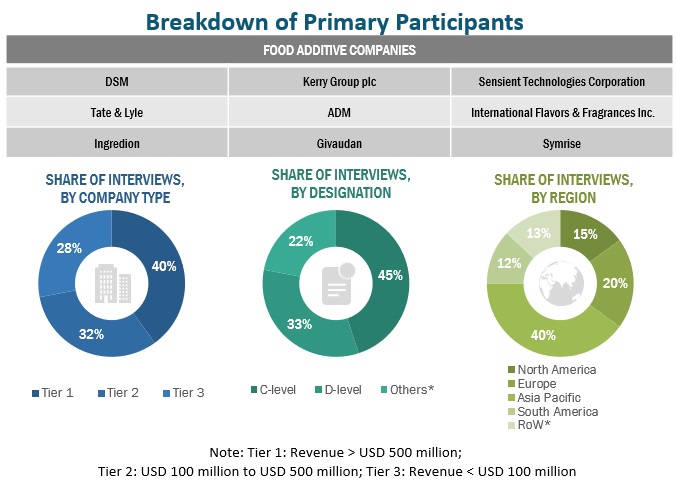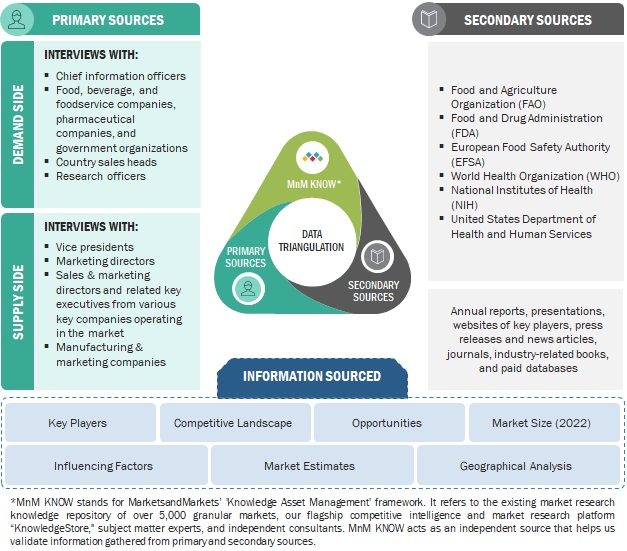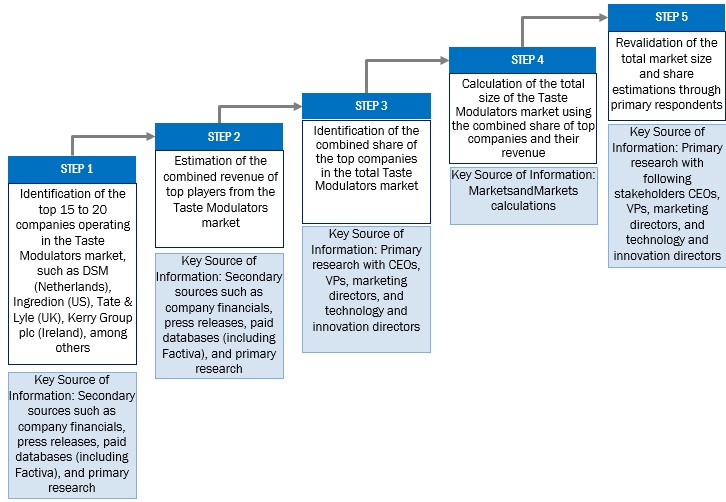This research involves the extensive use of secondary sources; directories; and databases (Bloomberg and Factiva) to identify and collect information useful for a technical, market-oriented, and commercial study of the Taste Modulators market. In-depth interviews were conducted with various primary respondents, such as key industry participants, Subject Matter Experts (SMEs), C-level executives of key market players, and industry consultants, to obtain and verify critical qualitative and quantitative information and to assess prospects.
Secondary Research
In the secondary research process, various sources, such as the Food and Agricultural Organization (FAO), United States Department of Agriculture (USDA), U.S. Food and Drug Administration (FDA) U.S. Food and Drug Administration (FDA), European Food Safety Authority (EFSA), World Health Organization (WHO), Consumer Healthcare Products Association (CHPA), European Federation of Associations of Health Product Manufacturers (EHPM), Canadian Health Food Association (CHFA), and Health Food Manufacturers' Association (HFMA), associations were referred to identify and collect information for this study. The secondary sources also include journals, press releases, investor presentations of companies, whitepapers, certified publications, articles by recognized authors and regulatory bodies, trade directories, and paid databases.
Primary Research
The Taste Modulators market encompasses various stakeholders involved in the supply chain, raw material manufacturers, raw material suppliers, regulatory organizations, and research institutions. To gather comprehensive information, primary sources from both the supply and demand sides were engaged. Primary interviewees from the supply side consisted of manufacturers, distributors, importers, and technology providers involved in the production and distribution of Taste Modulators. On the demand side, key opinion leaders, executives, and CEOs of companies in the Taste Modulators industry were approached through questionnaires, emails, and telephonic interviews. This approach ensured a comprehensive and well-rounded understanding of the Taste Modulators market from various perspectives.

To know about the assumptions considered for the study, download the pdf brochure
The top-down and bottom-up approaches were used to estimate and validate the market’s and various dependent submarkets’ size. The research methodology used to estimate the market size includes extensive secondary research of key players, reports, reviews, and newsletters of top market players, along with extensive interviews from leaders, such as CEOs, directors, and marketing executives.
Global Taste Modulators Market Size: Bottom-Up Approach
 To know about the assumptions considered for the study, Request for Free Sample Report
To know about the assumptions considered for the study, Request for Free Sample Report
Global Taste Modulators market Size: Top-Down Approach

Global Taste Modulators market size estimation: SUPPLY SIDE

Data Triangulation
The data triangulation and market breakdown procedures explained above were implemented, wherever applicable, to complete the overall market engineering process and arrive at the exact statistics for various market segments and subsegments. The data was triangulated by studying various factors and trends from the demand and supply sides. Along with this, the market size was validated using both the top-down and bottom-up approaches.
Market Definition
Taste modulators are substances used to restore any change in taste caused by using alternative food ingredients, providing the desired taste perception to a product. Sweet, salt, and fat modulators are available to compensate for the changes in taste that occur because of the use of low-calorie sugar substitutes, low-sodium salts, and fat reducers, respectively. These substances mask and modulate the taste of the respective substitutes, ensuring that the primary tastes of un-modified sugar, salt, and fat are emulated, in the absence of their presence.
Though the primary role of taste modulators involves the quality of taste, they also play a role in modulating the texture and mouthfeel of the food & beverage products that they are used in. Even though these substances play a role in changing more features than just the taste of a food or beverage product, it is important to note that these substances are not the same as flavor modulators.
Key Stakeholders
-
Taste modulator manufacturers and processors
-
Taste modulators traders, distributors, and suppliers
-
Food product manufacturers, processors, and traders
-
Food ingredient manufacturers, processors, and traders
-
Organizations such as the Food and Drug Administration (FDA), the US Department of Agriculture (USDA), the European Food Safety Agency (EFSA), and The International Food Additives Council (IFAC)
-
Government and research organization
-
Associations. regulatory bodies, and other industry-related bodies:
-
Food Processing Suppliers Association (FPSA)
-
Center for Innovative Food Technology (CIFT)
-
Food and Drug Administration (FDA)
-
European Food Safety Agency (EFSA)
-
The National Association of Flavors and Food-Ingredient Systems (NAFFS)
Report Objectives
-
To define, segment, and project the global market for Taste Modulators on the basis of type, application, and region
-
To provide detailed information regarding the key factors influencing the growth of the market (drivers, restraints, opportunities, and industry-specific challenges)
-
To strategically analyze the micro markets with respect to individual growth trends, future prospects, and their contribution to the total market
-
To analyze the opportunities in the market for stakeholders and provide a competitive landscape of the market leaders
-
To project the size of the market and its submarkets, in terms of value with respect to the regions (along with the key countries)
-
To strategically profile the key players and comprehensively analyze their market position and core competencies
-
To analyze competitive developments in the Taste Modulators market, including joint ventures, mergers & acquisitions, new product developments, and research & development activities
Report Scope:
Taste Modulators market:
By Type
-
Sweet Modulators
-
Salt Modulators
-
Fat Modulators
By Application
-
Food
-
Confectionery Products
-
Bakery Products
-
Dairy Products
-
Snacks & Savory Products
-
Meat Products
-
Other Food Applications
-
Beverages
-
Non-Alcoholic Beverages
-
Alcoholic Beverages
-
Pharmaceutical
By Region
-
North America
-
Europe
-
Asia Pacific
-
South America
-
Rest of the World
Available Customizations
With the given market data, MarketsandMarkets offers customizations according to company-specific scientific needs.
The following customization options are available for the report:
Product Analysis
-
Product Matrix, which gives a detailed comparison of the product portfolio of each company
Geographic Analysis
With the given market data, MarketsandMarkets offers customizations according to company-specific scientific needs.
-
Further breakdown of the Rest of the European Taste Modulators market, by key country
-
Further breakdown of the Rest of the Asia Pacific Taste Modulators market, by key country
-
Further breakdown of the Rest of South America Taste Modulators market, by key country
Company Information
-
Detailed analyses and profiling of additional market players



Growth opportunities and latent adjacency in Taste Modulators Market